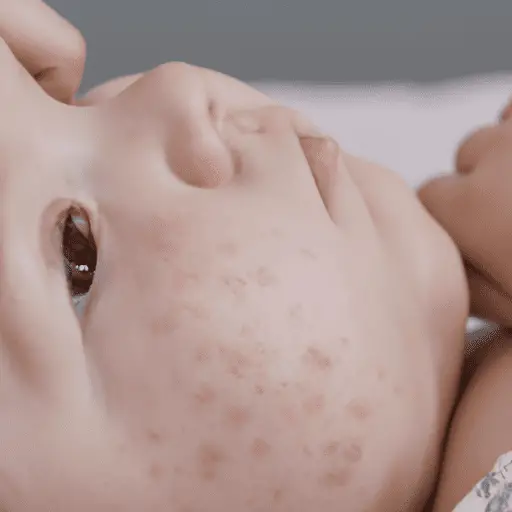-
Table of Contents
- Navigating Common Skin Issues in a Baby’s First Year
- Key Takeaways
- Introduction: Unraveling the Mysteries of Baby Skin
- Common Skin Issues in a Baby’s First Year
- Baby Acne
- Cradle Cap
- Diaper Rash
- Eczema
- Heat Rash
- FAQ Section: Common Questions About Baby Skin Issues
- 1. When should I consult a doctor for my baby’s skin issues?
- 2. Can I use adult skincare products on my baby?
- 3. How can I prevent diaper rash?
- 4. What causes eczema in babies?
- 5. Can baby acne be prevented?
- Conclusion: Navigating the Skin Terrain
- Key Takeaways Revisited
Navigating Common Skin Issues in a Baby’s First Year

[youtubomatic_search]
Key Takeaways
- Understanding common skin issues in a baby’s first year can help parents manage these conditions effectively.
- Common skin issues include baby acne, cradle cap, diaper rash, eczema, and heat rash.
- Most of these conditions are harmless and resolve on their own, but some may require medical intervention.
- Proper hygiene, regular skin checks, and using appropriate baby products can help prevent and manage these skin issues.
- Consulting a pediatrician is crucial when symptoms persist or worsen.
Introduction: Unraveling the Mysteries of Baby Skin
The first year of a baby’s life is filled with joy and challenges, one of which includes navigating common skin issues. Babies have delicate skin that is susceptible to various conditions, many of which can cause discomfort and concern for parents. This article aims to provide a comprehensive guide to understanding, managing, and preventing common skin issues in a baby’s first year.
Common Skin Issues in a Baby’s First Year
According to the American Academy of Pediatrics, some of the most common skin issues that babies encounter in their first year include baby acne, cradle cap, diaper rash, eczema, and heat rash.
Baby Acne
Baby acne, also known as neonatal acne, affects around 20% of newborns. It usually appears in the first month and resolves on its own within a few months. Baby acne is believed to be caused by maternal hormones that stimulate the baby’s oil glands.
Cradle Cap
Cradle cap, or seborrheic dermatitis, is a common condition that causes crusty or oily patches on a baby’s scalp. It usually appears within the first three months and can last up to a year or longer. The exact cause of cradle cap is unknown, but it may be related to overactive sebaceous glands.
Diaper Rash
Diaper rash is a common skin irritation that can cause a baby’s skin to become sore, red, scaly, and tender. It is usually caused by prolonged exposure to a wet or soiled diaper. Diaper rash can be prevented by changing diapers promptly and using a diaper rash cream.
Eczema
Eczema, or atopic dermatitis, is a chronic skin condition that causes red, itchy patches on the skin. It usually appears within the first six months to five years of a child’s life. Eczema is often associated with allergies and asthma, and it may be triggered by certain foods, irritants, or stress.
Heat Rash
Heat rash, or miliaria, is a skin condition that causes small, itchy red bumps on the skin. It is usually caused by overheating and excessive sweating. Heat rash can be prevented by dressing the baby in loose, lightweight clothing and keeping the baby cool.
FAQ Section: Common Questions About Baby Skin Issues
1. When should I consult a doctor for my baby’s skin issues?
If your baby’s skin condition persists, worsens, or is accompanied by other symptoms such as fever or lethargy, it is important to consult a pediatrician.
2. Can I use adult skincare products on my baby?
Babies have delicate skin that can be easily irritated by harsh chemicals found in adult skincare products. It is recommended to use products specifically designed for babies.
3. How can I prevent diaper rash?
Diaper rash can be prevented by changing diapers promptly, using a diaper rash cream, and allowing the baby’s skin to air dry before putting on a new diaper.
4. What causes eczema in babies?
Eczema is often associated with allergies and asthma, and it may be triggered by certain foods, irritants, or stress. However, the exact cause is unknown.
5. Can baby acne be prevented?
Baby acne is believed to be caused by maternal hormones and usually resolves on its own. There is currently no known way to prevent baby acne.
Conclusion: Navigating the Skin Terrain
Navigating common skin issues in a baby’s first year can be a daunting task for parents. However, understanding these conditions and knowing how to manage them can alleviate much of the worry. Most of these skin issues are harmless and resolve on their own, but it is important to consult a pediatrician when symptoms persist or worsen. Proper hygiene, regular skin checks, and using appropriate baby products can help prevent and manage these skin issues, ensuring your baby’s comfort and well-being.
Key Takeaways Revisited
- Understanding common skin issues in a baby’s first year can help parents manage these conditions effectively.
- Common skin issues include baby acne, cradle cap, diaper rash, eczema, and heat rash.
- Most of these conditions are harmless and resolve on their own, but some may require medical intervention.
- Proper hygiene, regular skin checks, and using appropriate baby products can help prevent and manage these skin issues.
- Consulting a pediatrician is crucial when symptoms persist or worsen.
[youtubomatic_search]

Leave a Reply